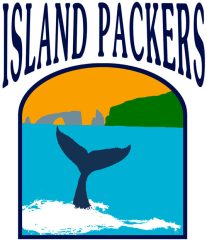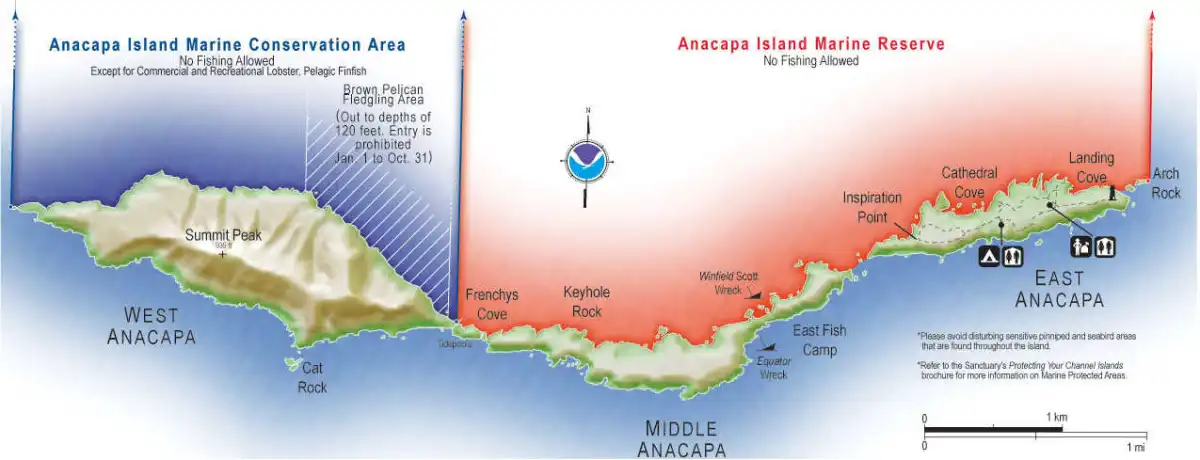ABOUT ANACAPA ISLAND

Discover Anacapa Island
While just 12–14 miles off the California coast, Anacapa Island remains one of Channel Islands National Park’s most exclusive destinations due to its challenging access. Low tides and a steep ladder landing (6-8 rungs, tide-dependent) make arrival an adventure in itself.
Island Highlights:
✔ Critical Wildlife Sanctuary: Home to one of California’s largest brown pelican breeding colonies and thriving western gull populations (April-August)
✔ Compact but mighty: This 1-square-mile island delivers dramatic cliffs, sea caves, and seasonal wildflower displays
✔ Year-round destination: Accessible in all seasons, though spring offers peak birdwatching opportunities
Important Access Notes:
- Landing requires navigating a tide-dependent vertical ladder (physical ability required)
- Visits are weather and sea condition permitting
The island’s protected status helps preserve its ecologically sensitive bird colonies
Anacapa Island Landing & Access
Landing Conditions & Cruise Details:
- Landing on Anacapa Island is **not guaranteed** and depends on sea conditions. The vessel captain will make the final decision on-site.
- If landing is not possible, the trip will continue as a half-day wildlife cruise, and ticket costs will be automatically prorated.
- Spring (March–May) often brings high winds, increasing the likelihood of cancellations.
Physical Ability Requirements:
- Stepping from the boat to a vertical ladder
- Climbing 1-8 ladder rungs (depending on tide conditions)
- Supporting full body weight during the transfer
Ladder Specifications:
- The ladder rungs are wider and spaced farther apart than standard ladders
- Passengers must have sufficient grip strength and mobility to use this equipment safely.
Visitors must then climb a 153-step stairway to reach the island’s trails.
Water Activities Advisory (Snorkeling/Kayaking/Scuba):
- Water activities can be rewarding but are physically demanding due to the landing facility’s design.
- Participants must have sufficient arm strength to:
- Climb a 15′-25′ ladder (tide-dependent) while carrying gear.
- Lift equipment unassisted (no hoist is available).
Kayakers: Must equip their kayak with a 5′-6′ bowline and a spring-loaded carabiner clip on the free end.
Note: For safety reasons, passengers unable to meet these requirements may be denied disembarkation.
Alert:
Click Map for a Larger View 🔍
THE THREE ISLETS
Anacapa is comprised of three small islets. The West Islet is the largest breeding site for California Brown Pelicans in all the United States. It is a restricted breeding area. Visitation to the Middle Islet is also restricted.
It is home to thousands of cormorants and the remnants of multiple sheep ranching efforts. Day visitors and campers at Anacapa are permitted to explore the East Islet, home to numerous Western gulls and some of the best views in California.
Photo: The three islets of Anacapa Island. Photo by Dan H.
VISITOR'S CENTER & FACILITIES
A small visitor’s center and park ranger housing can be found on Anacapa Island. The lighthouse, marking the eastern end of the Channel, can be found on the East islet also.
There is no potable water on Anacapa Island. Anacapa has very little shade. Visitors should come prepared with hat and sunscreen. Vault style restrooms are located near the visitor center and in the campground area. Several picnic tables are located in the visitor center area. Anacapa has seven campsites.
THE CLIMB TO THE TOP
The East End Landing Cove provides access to Anacapa Island. PLEASE NOTE:
- To reach the dock, you will climb 2-6 rungs of a ladder attached to the dock to reach the visitors center and hiking trails.
- Once on the dock, to reach the island’s plateau, passengers must climb 157 stairs.
Photo: 157 stair steps to the island’s plateau. Photo by Dan H.
ANACAPA STAIRWELL
The East End Landing Cove provides access to Anacapa Island. PLEASE NOTE:
- To reach the dock, you will climb 2-6 rungs of a ladder attached to the dock to reach the visitors center and hiking trails.
- Once on the dock, to reach the island’s plateau, passengers must climb 157 stairs.
Photo: 157 stair steps to the island’s plateau. Photo by Dan H.
SEA CONDITIONS ADVISORY
The Landing cove at Anacapa is more affected by sea conditions than other landing sites in the Park due to its size and orientation. Island Packers anticipates making landing on all scheduled trips.
However, landing decisions can frequently only be made on-site by vessel captains. As such, Island Packers does not guarantee landing at Anacapa Island. In the event a scheduled landing trip is unable to land, passengers will have ticket costs prorated.
THE EAST END LANDING COVE
Some of the best water activities in the park can be found at the East End Landing Cove. The cove has clear water and healthy kelp forests. You can experience fantastic swimming and snorkeling.
A modesty structure allows passengers to change clothes out of view. The landing cove is where the park’s Anacapa Live underwater video program is presented on Wednesdays in the Spring and Summer.
THE LIGHTHOUSE
The lighthouse on Anacapa was built in 1932. This was the last west coast lighthouse to be constructed. The other buildings on the east end of the island accompanied the light house.
These structures are built in the Missions Reveal style. These auxiliary buildings are still used as park, housing facilities for rangers and researchers.
SNORKELING & KAYAKING
Thick kelp beds and clear water in the landing cove and around the island’s shore, provide an excellent place to snorkel. Anacapa has 30 sea caves and provides beautiful kayaking.
Frenchy’s Cove is currently closed due to trail washout several years ago. Frenchy’s is an isolated gem, pristine in its ruggedness. There are no facilities or potable water on this part of the island. Visitors must come prepared with drinking water for the day. Camping is not permitted.
Photo: Kelp beds in the Landing Cove. Photo by Dan H.
FLORA & FAUNA
Two plant species that are found nowhere else on the planet can be found on this tiny island. It also shares 20 endemic species with the other islands in the chain.
A total of 265 plants varieties exist on this small island. The Anacapa Deer Mouse is endemic to the island.
Photo: Anacapa Deer Mouse, from National Park Service.
SEASONAL HIGHLIGHTS
-
 The Pacific Gray whale’s migration is January through Mid-April . In January you may be able to spot the whales from the top of the island. During the Gray whale migration, Island Packers will do its best to show our visitors these gentle giants while crossing to and from the islands. Bring your camera for some great pictures.
The Pacific Gray whale’s migration is January through Mid-April . In January you may be able to spot the whales from the top of the island. During the Gray whale migration, Island Packers will do its best to show our visitors these gentle giants while crossing to and from the islands. Bring your camera for some great pictures. -
 Anacapa is a rainbow of color created by the bloom of native wildflowers from February through April. Intensity and duration of the bloom differs a bit each year due to varied rainfall and temperature. The island comes alive with the cry of Western Gulls guarding their nests of eggs, as the spring bloom fades. Eggs usually hatch about 5 weeks after being laid. Chicks leave the nest at 6 to 7 weeks of age.
Anacapa is a rainbow of color created by the bloom of native wildflowers from February through April. Intensity and duration of the bloom differs a bit each year due to varied rainfall and temperature. The island comes alive with the cry of Western Gulls guarding their nests of eggs, as the spring bloom fades. Eggs usually hatch about 5 weeks after being laid. Chicks leave the nest at 6 to 7 weeks of age. -
 Just as the Western Gull chicks begin to leave the nest, park rangers begin the “Anacapa Live” video program. Visitors can experience a live virtual tour of the kelp forest during this program. Technology and specially outfitted dive helmets allow underwater divers to speak directly with the viewers in the landing cove. A digital connection is also made with the visitors center 14 miles away on the mainland. This program is scheduled for Wednesdays in Spring/Summer.
Just as the Western Gull chicks begin to leave the nest, park rangers begin the “Anacapa Live” video program. Visitors can experience a live virtual tour of the kelp forest during this program. Technology and specially outfitted dive helmets allow underwater divers to speak directly with the viewers in the landing cove. A digital connection is also made with the visitors center 14 miles away on the mainland. This program is scheduled for Wednesdays in Spring/Summer. -

A couple sitting on a bench at Inspiration Point
Enjoy the Channel Islands in our late Summer season. Sea conditions are generally agreeable, crowds are fewer and pleasant weather is the norm. Locals often wait for October for these optimal conditions, to head out to the islands. Water temps can stay in the mid- 60’s through October.
ADDITIONAL INFORMATION
PHOTO GALLERY
-
Photo by Lotti Keenan
-
Photo by Dan Harding
-
Photo by Dan Harding
-
Photo by Dan Harding
-
Photo by Dan Harding
-
Photo by Dan Harding
-
Photo by Dan Harding
-
Photo by Dan Harding
-
Photo by William (Bill) Dewey
-
Photo by Dan Harding
-
Photo by E. Thomas Smiley
-
Photo by Dan Harding
-
Photo by Dan Harding
-
Photo by Dan Harding
-
Photo by Dan Harding
-
Photo by Lotti Keenan
-
Photo by Dan Harding
-
Photo by Dan Harding
-
Photo by Dan Harding
-
Photo by Dan Harding
-
Photo by Dan Harding
-
Photo by Dan Harding
-
Photo by Dan Harding
-
Photo by Dan Harding
-
Photo by Ralph Custodio
-
Photo by Dan Harding
-
Photo by Dan Harding
-
Photo by Tim Hauf
-
Photo by Dan Harding
-
Photo by Dan Harding
-
Photo by Dan Harding
-
Photo by Dan Harding
-
Photo by Dan Harding
-
Photo by Dan Harding
-
Photo by Lotti Keenan
-
Photo by Dan Harding

